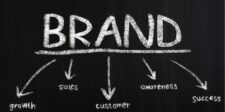Today, establishing a strong brand association is essential. Brand association is the mental links that consumers make between a brand and certain qualities, emotions, or experiences. It plays a critical role in defining consumer perceptions and driving loyalty.
Think about the immediate thoughts that come to mind when you hear names like Apple, Disney, or Nike. These aren’t just random associations but carefully cultivated connections between the brand and specific qualities like innovation, magic, or athleticism.
Such associations ensure that these brands are the first to come to mind in their respective domains. But what goes into an influential brand association?
Simplicity and Immediacy
The most powerful brand associations are both simple and immediate. For example, Tesla is synonymous with electric cars, and Google is synonymous with internet search. The simplicity of these associations allows for instant recall and connection, which should be the goal of every brand.
Emotional and Experiential Connections
Brands that succeed in creating emotional and experiential connections see deeper loyalty. Pixar, for instance, has masterfully associated its brand with profound emotional storytelling and unforgettable character development.
Films like “Up” and “Inside Out” entertain and evoke deep emotional responses that resonate with children and adults. This powerful engagement through emotions transforms casual viewers into lifelong fans, underlining Pixar’s status as a leader in animated storytelling.
Consistency
Consistency is the backbone of effective brand association. That means ensuring that every interaction—be it through product quality, customer service, digital platforms, or marketing communications—resonates with the brand’s core values.
This uniformity across various touchpoints reinforces brand associations and builds trust and reliability, which are integral qualities customers seek in every brand encounter.
By being consistent, you can cultivate a coherent and memorable brand identity that captivates and retains customers.
Types of Brand Associations
Depending on your brand’s focus, different associations may be more effective.
Celebrity-based: Associating with well-known personalities to borrow their qualities (e.g., George Clooney with Nespresso).
Founder-based: Leveraging the persona of a founder to enhance credibility (e.g., Elon Musk with Tesla).
Character-based: Creating memorable brand mascots (e.g., Tony the Tiger for Kellogg’s Frosted Flakes).
Tagline-based: Memorable slogans encapsulating your brand’s values (e.g., McDonald’s “I’m lovin’ it”).
Activity-based: Associating with specific activities that reflect the brand’s use case (e.g., Red Bull with extreme sports).
Building Your Brand Association Strategy
Start by defining the core values you want associated with your brand. Here are some examples.
- Innovation: Being seen as a leader in cutting-edge technology or creative solutions.
- Reliability: Known for consistent quality and dependability in products or services.
- Sustainability: Associated with environmental responsibility and ethical practices.
- Luxury: Implying high-quality, exclusivity, and premium status.
- Affordability: Offering good value, cost-effective solutions without compromising quality.
- Customer-centricity: Known for excellent customer service and putting the consumer first.
- Community involvement: Active participation in community service and local events.
- Wellness and Health: Promoting a healthy lifestyle and wellness through products or services.
- Adventure and Outdoors: Associated with outdoor activities and adventurous experiences.
- Family-friendly: Safe and suitable for all ages, appealing to family values.
- Youthfulness: Vibrant, energetic, and appealing to younger demographics.
- Artistic and Creative: Supporting or embodying the arts, creativity, and original design.
- Educational: Providing learning opportunities, informative content, and educational products.
- Safety: Emphasizing the security and safety features of products or services.
Once you’ve identified what you want to be associated with, develop a consistent messaging strategy that aligns with your values. And implement them across all marketing and communication efforts.
Use storytelling to make emotional connections, and leverage modern marketing tools to analyze and optimize your strategy. Remember, the goal is to forge positive and enduring connections that drive your brand forward.
A Word of Caution
Every time you introduce a new association, you may lose or alienate part of your audience. Whether that part is small or large will depend on how many people in your audience are pleased with the new association.
For instance, when Dunkin’ (formerly Dunkin’ Donuts) rebranded to emphasize its wider range of offerings beyond donuts, it risked losing traditional customers who cherished the original brand identity focused on donuts.
However, the rebrand was carefully managed to attract a broader audience interested in a wider variety of quick-service food and beverage options. When evolving your brand’s association, ensure you balance risk and reward.

I’m a freelance copywriter and SEO specialist. I aim to empower individuals and businesses with impactful marketing solutions and insights. In my downtime, I recharge by embracing the beauty of nature or cherishing moments with my loved ones. If you found value in this post, please consider sharing it.
Want a heads-up once a week whenever a new article drops?







